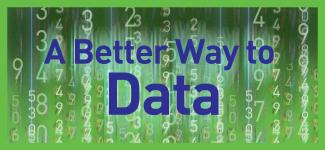
Financial Services Marketers, There’s a Better Way to Data
By Maxwell Chalkin, Chief Digital Officer and Senior Project Manager
Oh, data. What’s to be done with it? In the current climate, it is all-important for marketing leaders to base their strategic plans on sound data, but—especially in the world of financial services—there is such an abundance of data coming from so many sources that even knowing where to begin can be a challenge.
One place to start is to remember one crucial fact: data does not come from metrics; it comes from people. These people have rich lives, families, likes and dislikes. The data are merely heuristics that allow us to assemble a composite illustration of many consumers at once. Perhaps this is obvious, but it’s certainly easy to forget when you’re swimming in troves of numbers! Sure, it’s good to analyze numbers, but it’s better to do so through the lens of what do these numbers tell me about customers’ opinions, preferences, buying habits and priorities? Or what does this data tell me about what customers and prospects want and need, and can I provide those things?
So, dear financial marketers, by all means have a look at your data in the aggregate—your metanalyses, your impressions and CTRs, your cost-per-acquisition, your average daily balances, et cetera—, but get it out of your system… because there’s a better way. Ask yourself… what is really motivating my customers? (As every marketer knows, the answer is different for different customers.) It is at this intersection of big data and individual customers’ behaviors and attitudes where data analysis actually becomes useful.
Now, more than ever before, marketers have the ability to conduct truly meaningful customer segmentation. Sure, market research and demographic studies have long allowed marketers to build segments and adopt persona-based messaging strategies, but now big data, statistical analysis, machine learning and psychographic/behavioral metrics are within arm’s reach of the everyday marketer in a way these tools and tactics never were before.
Thanks to new technology, the cost of substantive data analysis has dropped precipitously in recent years. Methods of deciphering patterns of customer behavior and their underlying motivations and means of reconciling individual customer data with ethically-sourced publicly available large data sets—and then performing meaningful analysis on this customer and prospect data—are now readily attainable.
Let’s examine some real-world examples. For instance, just in the last few years, applied data science has made the following simple use cases increasingly viable for relatively unsophisticated and under-resourced marketers:
A. Lookalike Audiences
1. Identify which subset of my existing customers represent my most valuable customers.
2. Then, build and target an audience of prospects who look and act like my existing valuable customers.
B. “Next-Most-Likely” (or “Cross-Sell”)
1. Identify which of my customers are most likely to buy a second (or third) product.
2. Then, target those specific existing customers with an offer they can’t refuse.
C. Market Opportunity Predictions
1. Identify specific opportunities related to changes in your market landscape or pain points among your competitors’ customers (e.g., M&A/conversion activity, competitors’ missteps or blunders, regulatory/rate changes or seasonal cycles).
2. Then, predict the specific prospects who are most ripe for a targeted sell.
D. Needs/Behavioral/Psychographic Predictions
1. Build customer segments that cluster on the basis of true “Maslovian” needs—uncover what really motivates your customers (e.g., fraud, rates/fees, service, technology, et cetera).
2. Enhance qualitatively derived personas through secondary research and quantitative analysis.
3. Then, test and optimize marketing messages on discrete hybrid qualitative-quantitative segments.
Your customers are not a monolith. So, while it can certainly be worthwhile to look at aggregates, averages and cumulative data from UX/UI and campaign performance reporting, you may find that customer-level metrics, cluster and psychographic analysis, AI-based segmentation and machine-learned predictions are vastly more effective at helping you know your customer, surgically target impressions and touches, sell lower funnel and effectively control your media spend.
Even a small investment can yield big dividends in terms of reducing attrition, deepening relationships and growing market share. It’s data done better and it’s within the reach of savvy marketers now.
MKP communications inc. is a New York City-based communications company specializing in financial services marketing and merger/change communication.